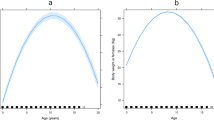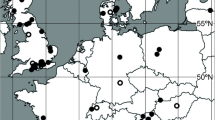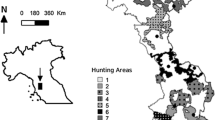Summary
We examined variation in fertility rates of red deer (Cervus elaphus) in five areas that cover a range of habitats in Belgium: Hautes Fagnes (3), middle of Ardenne (1) and Famenne (1).
In all areas, the majority of females ovulated for the first time as yearlings. The fertility rate (percentage of females ovulating) of yearlings varied from 0.48 to 0.91 between areas. The proportion of ovulating females 2-to-7-year-old exceeded 0.99 in all areas. The fertility rate decreased from 0.94 to 0.86 in 8-to-11-year-old females and fell to 0.50 in 12-year olds.
We developed logistic model to assess how age, body mass, mandible length, and area were linked to fertility in different age-classes.
In yearlings, mandible length, body mass and area variations were all significandy related to fertility when fitted individually. However, body mass explained the best the variation in fertility.
In the 1-to-7-year-old females, mandible length, body mass, age, and area variations were all significant when fitted individually to fertility. Mandible length was the most significant variable, but adding body mass in the model improved the fit significantly.
Although we observed significant between-area variations in fertility rate of yearlings, adding area in the logistic model did not improve the fits. This suggests that the fertility-mass relationship is the same between the five areas and that variation in fertility between areas reflects essentially between-area variations in mandible length and body mass.
Zusammenfassung
Wir untersuchten die Variation der Fruchtbarkeitsraten der Rothirsche (Cervus elaphus) in fünf Gebieten die sich in Belgien über eine Reihe von Lebensräumen erstrecken (Hautes Fagnes (3), Zentral Ardennen (1), und Famenne (1). In allen Gebieten hatten die meisten Weibchen als Jährlinge den ersten Eisprung. Die Fruchtbarkeitsrate (Prozent der Weibchen mit Eisprung) der Jährlinge schwankte von 0,48 bis 0,91 zwischen den verschiedenen Gebieten. Der Anteil der 2–7 jährige Weibchen mit Eisprung übertraf 0,99 in allen Gebieten. Die Fruchtbarkeitsrate nahm ab von 0,94 auf 0,86 bei den 8–11 jährigen Weibchen und fiel bis auf 0,50 bei den 12 jährigen Weibchen.
Wir entwickelten ein logistisches Model um die Einflüsse von Alter, Körpermasse, Unterkieferlänge, und Gebiet auf die Fruchtbarkeitstate der verschiedenen Altersklassen zu ermitteln.
Bei Jährlinge waren Unterschiede im Gebiet, in Unterkieferlänge und Körpermasse signifikant mit der Fruchtbarkeitsrate verbunden wenn jedes einzelner Faktor angepasst wurde. Die Körpermasse war aber der Hauptfaktor in der Erklärung der Variation der Fruchtbarkeitsrate. Bei den 1–7 jährigen Weibchen waren Variationen der Unterkieferlänge, Körpermasse und Gebiet alle signifikant wenn sie einzeln der Fruchtbarkeitsrate angepasst wurden. Der Faktor Unterkieferlänge war am meisten signifikant, aber zusammen mit dem Faktor Körpermasse passte er noch besser ins Modell. Obwohl wir signifikante Variationen der Fruchtbarkeitsrate der Jährlinge in verschiedenen Gebieten beobachten konnten, hat die Ergänzung des Faktors Gebiet zu dem logistischen Model die Passform nicht signifikant verbessert. Das weist darauf hin, dass die Relation Fruchtbarkeit — Körpermasse gleich ist zwischen den fünf Gebieten, und dass die Veränderung der Fruchtbarkeit zwischen den Gebieten hauptsächlich die Unterschiede in der Unterkieferlänge und der Körpermasse zwischen den Gebieten wiederspicgelt.
Similar content being viewed by others
References
Ahlen, I., 1965: Studies on red deer,Cervus elaphus L., in Scandinavia. III. Ecological investigations. Viltrevy3: 177–376.
Albon, S.D., Mitchel, B.B, Staines, B.W., 1983: Fertility and body weight in female red deer: a density-dependent relationship. J. An. Ecol.52: 969–980.
Albon, S.D., Mitchell, B., Huby, B.J., Brown, D., 1986: Fertility in female Red deer (Cervus elaphus): the effects of body composition, age and reproductive status. J. Zool., Lond.,209, 447–460.
Ansorge, H., Grunwald J., JeSchke, D., 1999: Alterstruktur und Reproduktion des Rotwildes (Cervus elaphus) in der Sächsischen Schweiz. Beitr. Jagd- Wildforsch.,24: 133–138.
Beninde, J., 1937: Zur Naturgeschichte des Rothirsches. Leipzig: Verlag Dr P. Schöps.
Bertouille, S.B. andde Crombrugghe, S.A., 1995: Body mass and lower jaw development of the female red deer as indices of habitat quality in the Ardennes. Acta Theriol.40 (2), 145–162.
Bubenik, A.B., Lochmann, J., Prusek, J., 1956: Biostatische Untersuchung einer Hirschbrunft. Z. Jagdwiss.2, 143–148.
Büchli, Ch., 1979: Zur Populationsdynamik, Kondition und Konstitution des Rothirsches (Cervus elaphus L.) im und um den Schweizerischen Nationalpark, Inaugural-Dissertation, Univ. Zürich, 1–99 + 1–22.
Clutton-Brock, T.H., Guinness, F.E., Albon, S.D., 1982: Red deer. Behaviour and ecology of two sexes. Chicago: University of Chicago Press.
de Crombrugghe, S.A., 1964: Untersuchungen über die Reproduction des Rotwildes in den Niederlanden. Z. Jagdwiss.10, 91–101.
de Crombrugghe, S.A., 1965: La densité de gibier. Bull. Royal St-Hubert Club Belg.4, 27–32.
de Crombrugghe, S.A., 1976: La détermination de l'âge chez le Cerf. Louvain-la-Neuve.
de Crombrugghe, S.A., 1989: Adéquation de la charge des ongulés sauvages en Hertogenwald et dans les Hautes Fagnes. Cah. Ecol. appl.,9, 445–466.
de Crombrugghe, S.A., Manet, B.J., 1994: Observations recueillies lors des séances de chasse à l'approche et à l'affût d'automne 1982 à 1993 dans les territoires expérimentaux de l'Hertogenwald et de St-Michel-FreŸr. Gembloux, Station Rech., for., Lab. Faune Sauv. Cynég., 1–18 + 3 ann.
Flueck, W.T., 1994: Erklärungshypothese zum Zusammenhang von Körpergewicht, Fettreserven und Ovulationsrate in nichtäquatorialen Cerviden. Z. Jagdwiss.40, 12–21.
Frisch, R.E., 1984: Body fat, puberty and fertility. Biol. Rev.59, 161–188.
Gaillard, J.M., Sempere, A.J., Boutin, J.M., Van Laere, G., Boisaubert, B., 1992: Effects of age and body weight on the proportion of females breeding in a population of roe deer (Capreolus capreolus). Can. J. Zool.70, 1541–1545.
Guinness, F.E, Albon, S.D., Clutton-Brock, T.H., 1978: Factors affecting reproduction in red deer (Cervus elaphus) hinds on Rhum. J. Reprod. Fert54, 325–334.
Hamilton, W.J., Blaxter, K.L., 1980: Reproduction in farmed red deer. I. Hind and stag fertility. J. Agric. Sci., Camb.95, 261–273.
Heltay, I.,Adorjan, A.,Sugar, L; 1983: Vergleichende Untersuchungen über die Fertilität und Embrionalentwicklung beim Rotwild in Ungarn. In Proc. XVI Congr. Int. Union Game Biol., pp 102–110.
Hewison, A.J.M., 1996: Variation in fecundity of roe deer in Britain: effects of age and body weight. Acta Theriol.41 (2), 187–198.
Joubert, D.M.,: Puberty in female farm animals. Anim. Breed. Abstr.,31: 427–438.
Kaposo, L.M., 1994: Charge relative exercée par le Cerf (Cervus elaphus L.) sur la végétation de deux massifs forestiers ardennais. Thèse doctorat. Univ. Cath. Louvain, Louvain-la-Neuve, 1–159.
Kroning, F., Vorreyer, F., 1957: Untersuchungen uber Vermehrungsraten und Körpergewichte beim weiblichen Rotwild. Z. Jagdwiss.3, 145–153.
Langvatn, R., Albon, S.D., Burkey, T., Clutton-Brock, T.H., 1996: Climate, plant phenology and variation in age of first reproduction in a temperate herbivore. J. Anim.Ecol.65, 653–670.
Lowe, V.P.W., 1969: Population dynamics of the Red deer (Cervus elaphus L;) on Rhum. J. Anim. Ecol.,38, 425–457.
Mitchell, B., 1973: The reproductive performance of wild Scottish Red deer,Cervus elaphus. J. Reprod. Fert., Suppl.19, 271–285.
Mitchell, B.,Brown, D., 1974: The effects of age and body size on fertility in female Red deer (Cervus elaphus L.). In Proc. XI Int. Congr. Game Biol., 89–98.
Mitchell, B., Lincoln, G.A., 1973: Conception dates in relation to age and condition in two populations of Red deer in Scotland. J. Zool., Lond., 1973, 171, 141–152.
Mitchell, B., Staines, W., Welch D., 1977: Ecology of Red deer: a research review relevant to their management in Scotland. Cambridge:.Institute of Terrestrial Ecology.
Müller-Using, D., 1976: Rotwildalter-Merkblatt. Schalenwildausschuss des Deutschen Jagdschutz-Verbandes, 1–20.
Sadleir, R.M.F.S., 1969: The ecology of reproduction in wild and domestic mammals. London: Methuen & Co. Ltd.
Sadleir, R.M.F.S., 1987: Reproduction of female cervids. In:Wemmer, C.M. (ed.).Biology and management of the Cervidae. Washington D.C.: Smithsonian Institution Press, 123–144.
Sokal, R.R., Rohlf, F.J., 1995: Biometry: the principles and practice of statistics in biological research. New York: W.H. Freeman and & Co., third ed.
Thamdrup, H., 1956: Das Rotwild Dänemarks. Z. Jagdwiss.2, 102–104.
Valentincic, S.I., 1960: Komparatieve Studie einiger Reproduktionerscheinungen beim Rotwild des Alpen- und Auegebietes. In Transactions 4th Congress Int. Game Biologists, Anhem, 188–197.
Wagenknecht, E., 1986: Das Rotwild. Berlin: VEB Deutscher Landwirtschaftsverlag.
Wegge, P., 1975: Reproduction and early calf mortality in Norwegian red deer. J. Wildl. Manage.39, 92–100.
Author information
Authors and Affiliations
Rights and permissions
About this article
Cite this article
Bertouille, S.B., de Crombrugghe, S.A. Fertility of red deer in relation to area, age, body mass, and mandible length. Zeitschrift für Jagdwissenschaft 48 (Suppl 1), 87–98 (2002). https://doi.org/10.1007/BF02192396
Issue Date:
DOI: https://doi.org/10.1007/BF02192396




